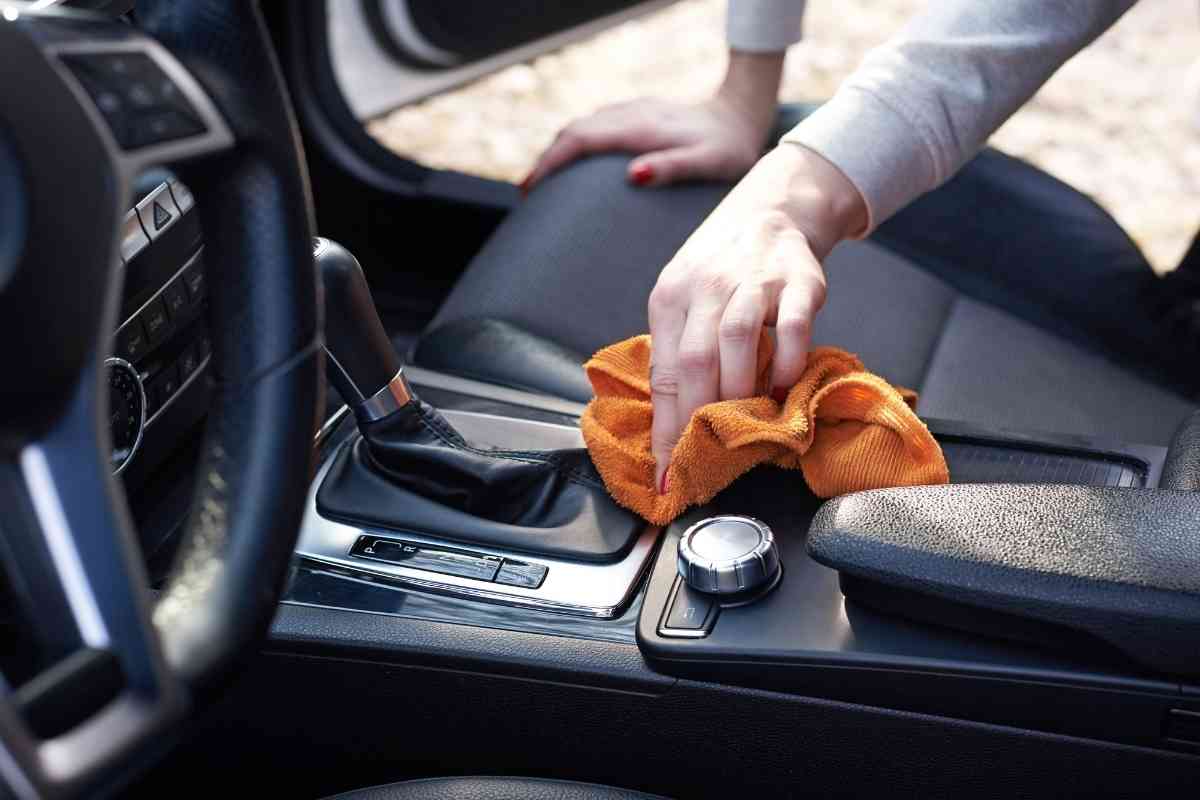6 Ways To Remove Scratches From Black Plastic Inside A Car
If you are trying to remove scratches from the black plastic interior of your car, there are several ways you can go about doing this that will be very effective. If you are someone who cares as much about what the interior of your car looks like as you care about the exterior’s looks, you probably have found yourself eyeing those scratch marks in your black plastic pieces with some concern. You’d like to make them go away, but you’re not sure how. And you certainly don’t want to spend a small fortune to have some professional do it if it’s possible you could do it yourself.

How do you remove scratches from the black plastic interior of a car?
Here are the 6 ways you can remove scratches from your black plastic car interior:
- Use Toothpaste Or Baking Soda
- Use Sandpaper
- Use A Polishing Compound
- Use A Heat Gun
- Use A Scratch Kit Specifically For Plastic
- Use Filler Putty And Grain Pads
It’s frustrating to look over at your dashboard or center console and see a scratch on the plastic surface. Cars are expensive, and we would like that they not only get us from Point A to Point B, but that we also enjoy our experience while driving them. Plus, we all know the value of our car will quickly decrease when it is no longer in good shape.
A scratch in our interior plastic is something we want to rectify, but how to go about it is something most of us don’t know the answer to. Let me help you find it!
I love my car, and spent a decent amount of time-saving for it. I also love my kids, but they seem clueless (it seems) for respecting it in the way I do..which leads to a lot of scratches on my plastic interiors where they put their feet, drink cups, and stuff. Luckily, I found a way to remove scratches from my car’s interior, despite what my kids do to it. Let me share with you my tried-and-true findings.
Ways To Remove Scratches From Black Plastic Interior
Plastic has often been used in the automotive industry for many purposes. Whether it’s for a functional reason or an aesthetic one, plastic has proven that its adaptability will mean its popularity is here to stay.
But – plastic is not the most forgiving material when it comes to scratches, scuff marks, and environmental damage (like too much sun) inside your car.
Plastic looks amazing until it gets damaged. But bringing it back to its original look is not that difficult if you are willing to try one of the following techniques:
1. Use Toothpaste or Baking Soda
For scratches that aren’t very deep, this is an excellent place to start.
When the plastic interior of your car has some unsightly, but probably just surface scratches, a good starting point for removing them would be to try something you have on hand, at home.
It’s always best to start with something easy and work your way up in level of difficulty and expense from there.
If you have some surface scratches on the interior plastic of your car, the best thing to try first that may remove them is either toothpaste or baking soda.
Both baking soda and toothpaste have an abrasive chemical compound that makes them ideal for cleaning away dirt and debris and buffing out scratches.
If a scratch on your black plastic is pretty surface, a household hack like toothpaste or baking soda may do the trick.
Both toothpaste and baking soda have ingredients like sodium carbonate that allow them to have a bit of an abrasive element. This works extremely well when it comes to cleaning hard surfaces, as well as removing surface scuff and scratch marks.
Mix the toothpaste or baking soda with a bit of water in order to form a paste. Then, put a thin layer of the paste over the plastic scratches, making sure to coat all of them evenly.
Let the paste sit for a minute or two. Then, after it has had a chance to harden a bit, gently wipe away the paste mixture with a clean microfiber cloth and allow the area to fully dry.
Your scratch marks may be gone. If not, time to try the next option.

2. Use Sandpaper
If toothpaste or baking soda aren’t enough to help rid your black plastic of the scratches, you may need something that is just slightly more abrasive.
Sandpaper is a great option for getting rid of surface scratches on your interior black plastic. As its name implies, its main job is to change and transform surfaces.
Sandpaper is nothing more than paper that has had a glue-like substance added to it that gives it a tacky, rough exterior. This is great for times when you need to smooth out something or bring two surfaces flush with one another.
When using sandpaper to remove scratches from black plastic car interiors, start by gently using a medium-rough piece of sandpaper. Rub the sandpaper against the scratch, moving it across the scratch from one end of the scratch to the other.
Don’t rub the sandpaper across the scratch, as this could cause more small scratches to occur.
After you sweep the sandpaper across the scratch a few times, you should see it start to disappear. If not, it’s time to try the next step.
3. Use a Polishing Compound
If neither sandpaper or a home remedy (like toothpaste or baking soda) worked, it’s time to try something a bit more aggressive for the scratches on your car’s black plastic interior.
The next option would be a polishing agent that is made specifically for cars and car scratches.
Last update on 2025-12-18 / If you click this affiliate link and make a purchase, we earn a commission at no additional cost to you.
There are a variety of polishing agents on the market, and you can buy them everywhere, from purchasing them online, to buying them at your local auto parts or homegoods store.
Polishing agents work like toothpaste or baking soda. They have abrasive ingredients that allow them to interact with the surface of a material – like plastic – and level out surfaces, causing scratch marks to disappear.
Dab a bit of the polishing agent on the scratch, being sure to completely coat the area of concern. You can then use either a microfiber cloth or even a bit of sandpaper to work the polishing agent into the scratch.
Wait a minute or two then wipe away the compound. When dry, look at the scratch. If it is still no better, you will need to consider the next step to ridding your interior black plastic of those unsightly scratches.
4. Use a Heat Gun
If none of the above options have worked on your interior scratches, you may want to consider using a heat gun as the next level of trying to get rid of those annoying imperfections in your black plastic.
Last update on 2025-12-18 / If you click this affiliate link and make a purchase, we earn a commission at no additional cost to you.
Heat guns are similar to blow dryers. They will warm up a surface to a specific temperature, depending on their capability and what you program them to. They are safe to use under most circumstances, but always check and make sure the plastic area you are heating up doesn’t have some cause for concern.
Plastic softens under heat, so using a heat gun on your interior scratch area will mean that your plastic surface will become more malleable when warm.
Once hot, you can use a piece of sandpaper or a microfiber cloth (or both) to gently buff and polish the scratched area…hopefully buffing and polishing out the scratch from the plastic.
Be careful when you are using sandpaper on a plastic surface after heat has been applied to it. Because it will be softer and more malleable, you want to make sure you don’t do increased damage to the compound when manipulating out the scratch.
If – after the heat gun – the scratch is still there, you probably need to move on to the next level of problem-solving for your interior car scratches.
5. Use a Polish Kit Specifically for Plastic
Last update on 2025-12-18 / If you click this affiliate link and make a purchase, we earn a commission at no additional cost to you.
A plastic scratch polish kit will be more effective for scratches that are deeper or more significant than what a polishing agent or a heat gun can repair.
Polishing kits are often used by professional automotive detailers to buff and scuff out scratches that are significant…whether they are on the inside or outside of your vehicle. Polishing kits don’t need sandpaper to
When you choose a plastic scratch polish kit, make sure it’s one you can use for all your vehicle plastic cleaning needs. Follow the directions on how to use this cleaning agent and this may take care of the plastic scratch issue you’re experiencing.
If not, here’s another option.
6. Use Filler Putty and Grain Pads
If the scratches on your interior plastic are significant and deep enough that you can’t get rid of them by any of the above means, you might need to invest in some filler putty and grain pads to do the job.
Last update on 2025-12-18 / If you click this affiliate link and make a purchase, we earn a commission at no additional cost to you.
Filler putty is a fantastic compound for filling scratches that are deep enough that they need more than just scuffing and buffing to repair. Typically used for drywall or home maintenance projects, filler putty can be extremely effective on car scratches as well, especially interior ones that won’t be later exposed to harsh environmental elements, like sun, rain, or extreme heat.
If scuffing out or sanding down a scratch hasn’t worked for your interior black plastic car scratch, you may want to consider buying some putty to fill in the mark instead of trying to get rid of it.
Filler putty is widely used for a variety of things. When you combine it with the right application product, it will work wonders for filling in those pesky plastic scratches on the interior of your car…those scratches that nothing else seems to be able to fix.
Grain pads are just abrasive enough to be able to help apply filler putty to the black scratches on your car’s interior, without damaging the plastic around them.
Last update on 2025-12-18 / If you click this affiliate link and make a purchase, we earn a commission at no additional cost to you.
Like sandpaper, grain pads will help buff out the fine scratches of your car’s plastic but come in different levels of abrasiveness, depending on how deep or significant the scratches are.





